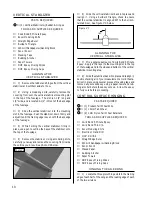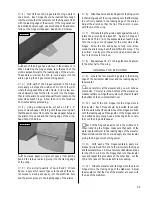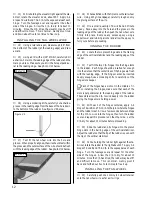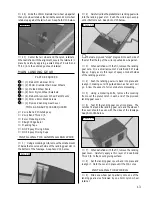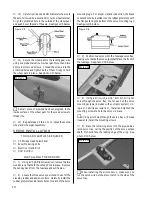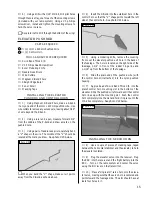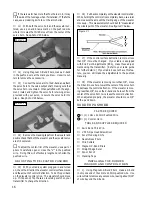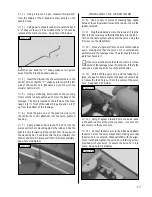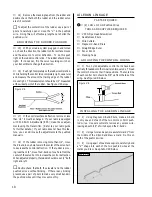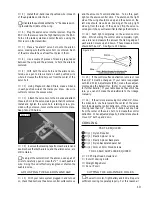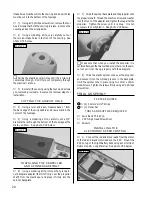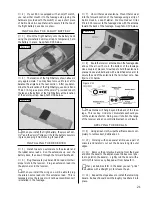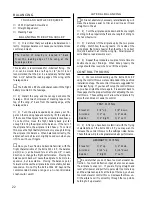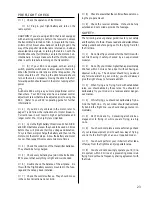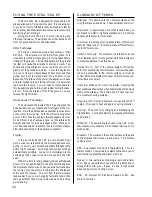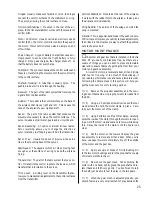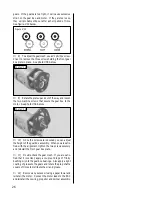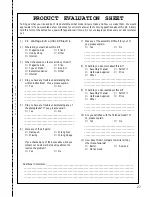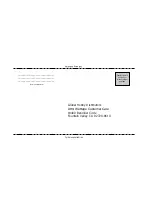
24
FLYING THE EXTRA 330L EP
The Extra 330L EP is designed for those pilots who
are experienced in flying sport models. It is not a trainer.
If you do not feel comfortable that you are able to test fly
the airplane, don't hesitate to ask someone for some help
test flying and trimming it.
Flying the Extra 330L EP is much like flying any
other sport airplane. The airplane can either be taken off
from the ground (ROG) or hand-launched.
ROG Technique
To ROG you should be using a hard runway or firm
dirt strip. The airplane will not ROG from grass. It is
important to let the airplane get up to flying speed before
lifting off the ground. Lifting the airplane off the ground
too fast will cause the airplane to stall and crash. You
should allow the airplane to roll out until the tail is com-
pletely off the ground and flying. Allow the airplane to
roll out on its main wheels about 50 feet more and then
gently pull it off the ground and into a shallow climb.
Because of the torque of the motor, the airplane will have
a natural tendency to pull to the left when it is accelerat-
ing down the runway. You will need to compensate for
this by applying and holding right rudder during the take-
off roll. Once the airplane lifts off the ground, you can
release the right rudder.
Hand-Launch Technique
To hand-launch the Extra 330L EP, gently grasp the
belly pan between your thumb and forefingers at the C.G.
location. Hold the airplane above shoulder level and turn
on the motor to full power. With the motor running at full
power, firmly toss the airplane straight ahead and level.
Do not throw it up at a steep angle. Let the airplane fly
straight and level to pick up airspeed, then climb up to
your desired altitude. Be careful not to climb too steeply
after hand-launching or the airplane could stall.
Flying
In the air the Extra 330L EP is a very smooth flyer.
Set up with low rate settings, the airplane behaves very
gently. It will fly very smooth and stable throughout the
entire flight envelope. With high rate control settings,
aerobatics are possible. Loops, rolls, immelmann turns,
knife edge flight, snap rolls and more can be done with
ease.
When it is time to land, gradually reduce altitude and
power. It is not a good habit to chop the throttle and dive
the airplane to the runway. When you are a few feet above
the runway, turn the motor off and allow the airplane to
settle onto the runway. You will find that the airplane
lands easier if you come in slightly faster and land on the
main gear rather than trying to slow down to do a three
point landing.
Ailerons:
The ailerons are the control surfaces on the
wing that move up and down. These surfaces control roll.
Blind Nut:
A special type of nut that is used when you
can't reach to install or tighten a standard nut. A blind nut
has prongs that secure it into place.
C/A Glue:
An acronym for Cyanoacrylate. It dries very
fast like "Super Glue." It comes in many different formu-
las for different uses.
Center of Gravity:
Most commonly referred to as the
CG or balance point, it is the point at which the airplane is
in complete balance in all three axes.
Control Horn:
Part of the control system, the control
horn is mounted to the control surface. It allows the push-
rod to be connected to the control surface. Almost all
control horns are adjustable to allow for more or less con-
trol surface movement.
Covering:
Made out of vinyl or polyester. Covering has
heat sensitive adhesive that, when heated, sticks to the wood
frame of the airplane. The Extra 330L EP uses real iron-
on polyester covering material.
Covering Iron:
A small hand-held iron, usually Teflon
®
coated. It is used to heat and apply covering material.
Cycling:
The act of fully charging and discharging the
flight battery. Cycling the battery increases performance
and duration.
Dihedral:
The upward angle of each wing half. Dihe-
dral creates more stability which makes learning to fly
much easier.
Elevator:
The elevator is the control surface on the back
of the airplane that moves up and down. This surface
controls pitch.
EPA:
An acronym for End Point Adjustments. This is a
feature found on newer radio systems that allows you to
electronically adjust the end-travel in servos.
Epoxy:
A two-part glue containing a resin and a hard-
ener. Epoxy is available in several drying times and is
stronger than C/A glue. Epoxy is used in high stress
areas such as joints of wing halves.
ESC:
An acronym for Electronic Speed Control. See
Motor Controller.
GLOSSARY OF TERMS

